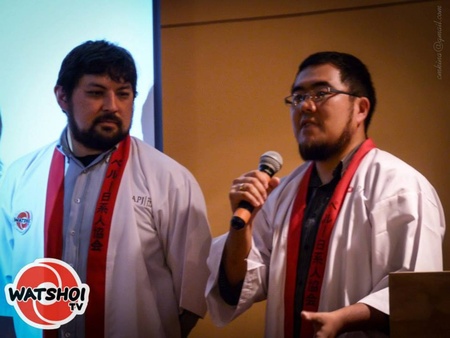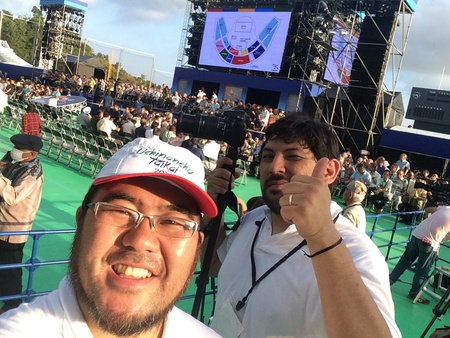
The word onigiri , even to those familiar with Japanese food, is catchy. It has magnet, hook. It was the name that the communicator Gerardo Higa Arakaki chose to baptize an online university venture that spread manga and anime in Peru in the 2000s.
That playful bet of youth, Onigiri TV, was transformed over the years into a company, Onigiri Producciones, directed by Gerardo and his school friend, Gustavo Barreda Fudimoto, which makes documentaries on the history of Japanese immigration to Peru, broadcasts events of the Nikkei community live and produces a YouTube channel that acts as a bridge with communities of Japanese origin in other countries, among other things.
QUALITATIVE LEAP
In the professional lives of Gerardo and Gustavo there was a springboard: Watshoi TV. It was like reaching the major leagues. The Peruvian Japanese Association (APJ), through its Youth Department, entrusted them in 2013 with the creation of an internet channel to disseminate the institution's activities among Nikkei young people in an agile way and, thus, bring them closer to the community.
It was no longer a matter of covering events about manga and anime that could attract an audience or not, go well or badly, in short, which were done as best they could, but rather an institutional project that, although it sought to attract a young audience with a proposal fresh, far from rigidities, its preparation and staging entailed order, structure and responsibility.
The qualitative and quantitative leap to Watshoi TV involved for both of them the acquisition of more equipment, the recruitment of collaborators, the expansion and diversification of their operations and, above all, their immersion in the Nikkei community, the entry into a world that opened many doors.
Little by little they began to make their way. Since then they have made four historical documentaries: Chancay Nikko , Odori: 110 years of history and tradition in Peru , Descendientes (testimonies of four Nikkei of Okinawan origin) and an unpublished one about the yanaconas (Issei farmers) that they hope to publish this year .
Rubén Sugano, goodwill ambassador of Okinawa and disseminator of the history of Japanese immigration, was key in Onigiri's approach to documentaries.
Likewise, they became the transmitters of the matsuri of the La Unión Stadium Association, the annual activity organized within the Nikkei community that gathered the most people before the coronavirus pandemic (up to 20 thousand people).
As they became known, they also did work with other institutions, such as prefectural organizations (kenjinkai, shi-cho-son).
Things were not easy at first. Gerardo and Gustavo had to overcome the resistance or skepticism of those who did not believe in broadcasting events over the internet, at a time when physical formats were still opted for.
Gustavo remembers that there were people who asked them where they could buy the recordings, if they sold DVDs, etc. When they responded that they could watch them online, that anyone—from anywhere in the world—could do so, that they were available on YouTube, their interlocutors had a hard time assimilating the innovation. It was necessary to “break mental structures,” he says.
Once the videos were published on the Internet, a new obstacle loomed: that the Nikkei would comment on social networks or virtual platforms. Now it is common, but not at that time. Their participation was limited to likes. There were no comments. The lack of expressiveness of those of Japanese descent was also noticeable online, until they gradually got used to expressing themselves.
Watshoi TV ended a cycle, but Gustavo and Gerardo did not sit back and opened a new channel, Kizuna TV, which shows the world the Peruvian Nikkei community, its history and activities.
One of the sections of the channel is “Ganbatte”, dedicated to Nikkei businesses, such as restaurants. At first its protagonists were exdekasegi, but later it opened up to the rest of the community.
Onigiri Producciones grew, inside and outside the community, also embarking on streaming product launches, making institutional videos, managing social networks for organizations, among other tasks.
The venture of the two school friends became a company with ten workers, marketing and design departments, a calendar full of work projects, until the pandemic arrived and, like everyone else, they stopped dead.
SURVIVING THE PANDEMIC
Today, only Gustavo and Gerardo remain from Onigiri Producciones. At the head of the company, they gave their people wings to fly to other destinations due to the shortage of jobs.
Fortunately, with the country settled into a strange normality forced by the virus, the projects began to arrive (although without reaching pre-pandemic levels). “Thank God there was work,” says Gerardo. When necessary, they call on their former collaborators for specific jobs.
In this peak year of the pandemic, Onigiri has been in charge of the online transmission of events such as the Nikkei Young Art Salon, the Nikkei Congress or the Peru Kohaku Uta Gassen.
In parallel, they launched the magazine Gambateando, which was born as a directory of Nikkei companies, and which today is a publication with articles, interviews and a cultural section by the sculptor Haroldo Higa, promoter of young Nikkei art.
YOUR STORY, YOUR FAMILY
Gerardo and Gustavo have known each other since they were studying at the Peruvian-Japanese school La Victoria. As members of the Nikkei community, they knew a little about their history, but it has been thanks to their work that they have deepened their knowledge of it and, in particular, revalued their family as part of a group with 122 years of presence in Peru. .
“How I would like to interview my grandparents, my mother, who are no longer here,” says Gustavo, who has interviewed numerous Nikkei to investigate their stories. He could not do the same with his ancestors and he would have liked, for example, to question his grandparents about their lives in Barranca, the province where they, as well as many Japanese immigrants, settled.
Knowing the story better has helped him understand things that were previously difficult for him to understand, such as the fact that his grandmother did not speak Japanese with him. Gustavo understood that due to the traumatic consequences of the war, immigrants preferred that their children be educated as Peruvian citizens, which is why the transmission of nihongo lost strength. He also understood family customs or habits. “You understand your family better,” he points out. “If you don't look for your story, you won't understand.”
Diving into history has also allowed him to be aware that if institutions like APJ exist today, it was because before there were people who built it and contributed ideas and arms for it to grow. “There is a job before me,” says Gustavo, as a member of a community that advances what was forged by its ancestors.
The Nikkei see institutions, buildings, infrastructure, and take them for granted, not knowing how they were built, he adds.
In Gerardo's case, research in search of input for documentaries has brought him closer to his family history, making it possible for him to know his ancestors better. His grandmother, for example, was one of the first odori teachers in Peru, and his grandfather taught at Lima Nikko, the largest Japanese school in the community, closed during World War II. The more you know, the more you value and the more you want to know, stand out.
The work has brought them satisfaction. Bringing young Nikkei closer to their community, to their institutions, is one of them. “We have brought people together, it has been something very nice,” he says. Knowing countries, people, stories, is another. Gerardo remembers in particular his experience in Okinawa in 2016, to record the Uchinanchu Taikai. "It was incredible".
All jobs have represented a challenge for both of us. “We have all learned something,” says Gustavo. For his part, Gerardo wants everything they have done, he has no preference for any in particular.
There are no limits for them. “We make the crazy ideas you have come true. They didn't even think it was possible, but we did it,” says Gerardo, referring to his clients.
PENDING DREAM
Years ago, Gustavo and Gerardo began asking people of Japanese descent from all walks of life, from renowned artists to ordinary people, what it means to them to be Nikkei.
Its objective? Make a documentary about Nikkeidad. And not only in Peru, they have also asked the question in Argentina. His idea was to take the project to Japan, where the meaning of being Nikkei does not necessarily coincide with that of the descendants in Peru. A promising project that did not advance further due to lack of financing, but which they hope to resume. Someday the pandemic will end and his dream will still stand.
© 2021 Enrique Higa Sakuda







